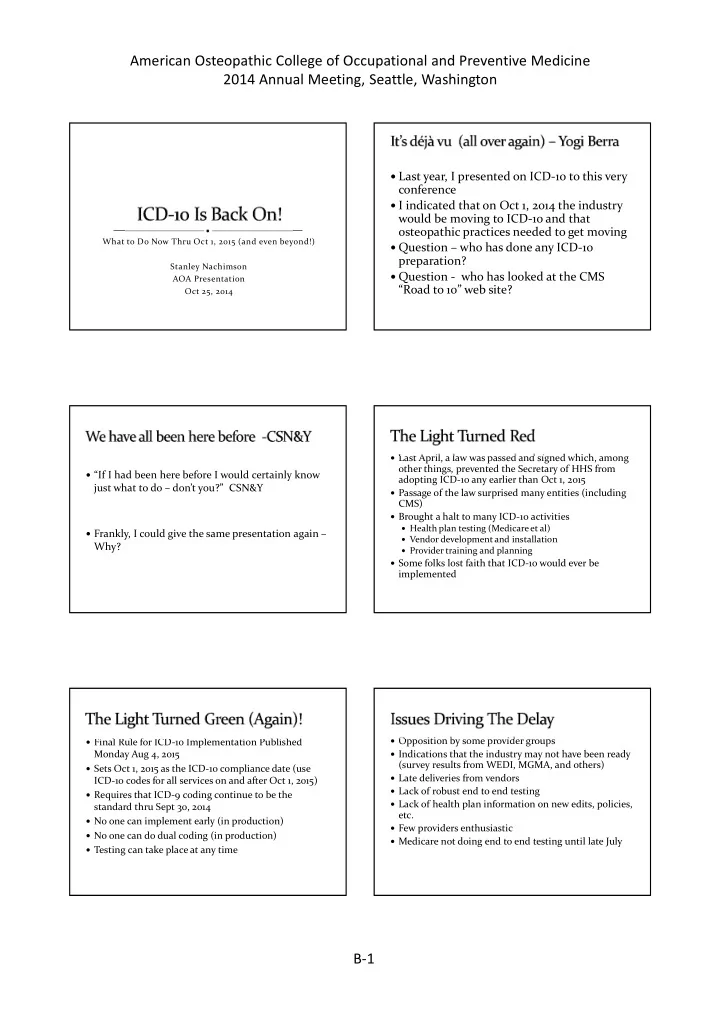

American Osteopathic College of Occupational and Preventive Medicine 2014 Annual Meeting, Seattle, Washington Last year, I presented on ICD-10 to this very conference I indicated that on Oct 1, 2014 the industry would be moving to ICD-10 and that osteopathic practices needed to get moving What to Do Now Thru Oct 1, 2015 (and even beyond!) Question – who has done any ICD-10 preparation? Stanley Nachimson Question - who has looked at the CMS AOA Presentation “Road to 10” web site? Oct 25, 2014 Last April, a law was passed and signed which, among other things, prevented the Secretary of HHS from “If I had been here before I would certainly know adopting ICD-10 any earlier than Oct 1, 2015 just what to do – don’t you?” CSN&Y Passage of the law surprised many entities (including CMS) Brought a halt to many ICD-10 activities Health plan testing (Medicareet al) Frankly, I could give the same presentation again – Vendor development and installation Why? Provider training and planning Some folks lost faith that ICD-10 would ever be implemented Opposition by some provider groups Final Rule for ICD-10 Implementation Published Monday Aug 4, 2015 Indications that the industry may not have been ready (survey results from WEDI, MGMA, and others) Sets Oct 1, 2015 as the ICD-10 compliance date (use Late deliveries from vendors ICD-10 codes for all services on and after Oct 1, 2015) Lack of robust end to end testing Requires that ICD-9 coding continue to be the Lack of health plan information on new edits, policies, standard thru Sept 30, 2014 etc. No one can implement early (in production) Few providers enthusiastic No one can do dual coding (in production) Medicare not doing end to end testing until late July Testing can take place at any time B-1
American Osteopathic College of Occupational and Preventive Medicine 2014 Annual Meeting, Seattle, Washington New Date - Oct 2015 Other than that, not very much has changed What we were doing before was not working What can provider groups do to drive themselves and the industry forward? Need to change messaging to providers Need to provide clearer path to implementation Determine the status of your implementation – That’s the same message for any project What have you done? That’s the message that wasn’t working What needs to be done – training, system upgrades, Need to get started process review, etc. What should we change! Build new project timeline Leave time for testing Question – what do you think is the first step? Restart the efforts Collaboratewith peers I looked at my presentation last year – and I see the Patient history and treatment problem Better information exchange The one item osteopathic practices should be working Better coding (and maybe better reimbursement) on is CDI Audit protections There will be benefits whether or not we move to ICD- 10 B-2
American Osteopathic College of Occupational and Preventive Medicine 2014 Annual Meeting, Seattle, Washington Step 1 – Identify high priority diagnosis groups for your Step 2 – Collect samples of your documentation for practice (not individual codes) these cases Step 3 – Look up the ICD-10 codes for these types of problems Highest revenue Highest volume Step 4 – Understand the documentation and Most complex descriptions for these codes Health plan denials or requests for information Use past year’s records, information from health plans or clearinghouses, or other sources of compiled data. Don’t rely on guessing – use the data Step 5 – Compare your current documentation to the documentation requirements and descriptions for the Note that you will need to document if this is Type 1, ICD-10 codes Type 2, drug or chemical induced, or due to underlying Step 6 – Determine what you may need to do to get condition your documentation to support the ICD-10 codes Note you will have to document with or without coma Note you will have to document the manifestation of the disease (e.g. ketoacidosis, opthalmic) Note use of insulin 16 Once you have identified opportunities for CDI, take Plan for upgrades the necessary steps to implement them. Get information on timing, cost, support Changes in forms or EHRs Sooner is better! Staff training Questions for patients Question – Who has gotten information from your vendors on ICD-10? B-3
American Osteopathic College of Occupational and Preventive Medicine 2014 Annual Meeting, Seattle, Washington Voluntary accreditation program for practice management systems Providers have long depended on vendors for meeting Criteria will include HIPAA EDI and ICD-10 the HIPAA EDI mandates capabilities, privacy and security, revenue cycle Vendors are often blamed for lack of provider management, customer support, readiness. readiness. Will give providers assurance that their PMS meets Providers need assistance in judging vendor basic requirements capabilities Following the EHNAC process for program EHNAC and WEDI are developing the PMSAP development In beta testing now Expectation to be ready 1 st quarter 2015 What are they doing for ICD-10? Time What resources are available? Resources When can I test? Collaboration Question – who has gotten information from your health plans on ICD-10? No doubt some providers may not be ready, or have ICD-10 will never happen some hiccups in implementation There are too many codes May be some issues with some health plans It doesn’t impact me because I get paid via contract or Develop and share contingency plans appropriately CPT code Not a substitute for being ready My vendor or clearinghouse will take care of this Should be time limited I don’t have to do it May involve some cost Emphasize the Oct 1, 2015 date for being ready B-4
American Osteopathic College of Occupational and Preventive Medicine 2014 Annual Meeting, Seattle, Washington Do The CDI – it will pay off Stanley Nachimson Nachimson Advisors LLC Nachimson_advisors@verizon.net B-5
Recommend
More recommend